為了這款芯片,AMD賭上了一切
|
從四樓辦公室的大窗戶向外望去,蘇姿豐的目光從AMD的奧斯汀園區(qū)掃過,然后落在測試新型芯片的實(shí)驗(yàn)室大樓上。2016年春天,蘇姿豐經(jīng)常會看著這個大樓,給在此工作的員工發(fā)短信、即時消息以及打電話更是家常便飯。當(dāng)時她正急切地等待著齊柏林飛艇(Zeppelin)的誕生。 齊柏林飛艇是AMD最新微處理器的代號,這款旗艦產(chǎn)品將用于個人電腦和企業(yè)級服務(wù)器——AMD的未來也有賴于它的成功。作為電機(jī)工程博士,蘇姿豐2014年成為AMD首席執(zhí)行官。當(dāng)時這家芯片制造商生意慘淡,銷售額不斷滑坡。蘇姿豐努力讓AMD的產(chǎn)品重新煥發(fā)生機(jī),齊柏林飛艇則是她的第一項(xiàng)成果。該產(chǎn)品使用的芯片經(jīng)過了徹頭徹尾的重新設(shè)計(jì),有望在運(yùn)算需求密集的消費(fèi)者群體中得到青睞,不管是挑剔的游戲玩家,還是運(yùn)行人工智能和機(jī)器學(xué)習(xí)程序的科技公司。如果這款新產(chǎn)品大獲成功,AMD就有可能扭轉(zhuǎn)連年虧損的局面,甚至從英特爾和英偉達(dá)等對手的陰影中走出來。 蘇姿豐沒想到的是,當(dāng)齊柏林飛艇最終“抵達(dá)”奧斯汀時,它一度有可能“墜毀”。 |
From the wide windows of her fourth-floor office, Lisa Su can look across the Austin campus of Advanced Micro Devices and see the laboratory building where the company’s new chips get tested. In the spring of 2016, Su was looking in that direction quite often, not to mention texting, instant messaging, and calling the staffers who worked there. She was waiting eagerly for a Zeppelin to arrive. Zeppelin was the code name for AMD’s (amd) newest microprocessor, a flagship chip designed to run in personal computers and corporate servers—and the company’s future was riding on its success. Su, a Ph.D. microprocessor engineer herself, had become CEO in 2014 in the midst of a dismal sales decline for the chipmaker. Zeppelin was the first fruit of her effort to revive AMD’s product line, with redesigned-from-the-ground-up chips that could woo customers with intense computing needs, from finicky video gamers to tech companies running artificial intelligence and machine learning programs. If the new products thrived, AMD stood a chance of reversing years of losses, and even emerging from the shadow of rivals like Intel and Nvidia. What Su didn’t anticipate was that when the Zeppelin finally got to Austin, it would crash-land. |
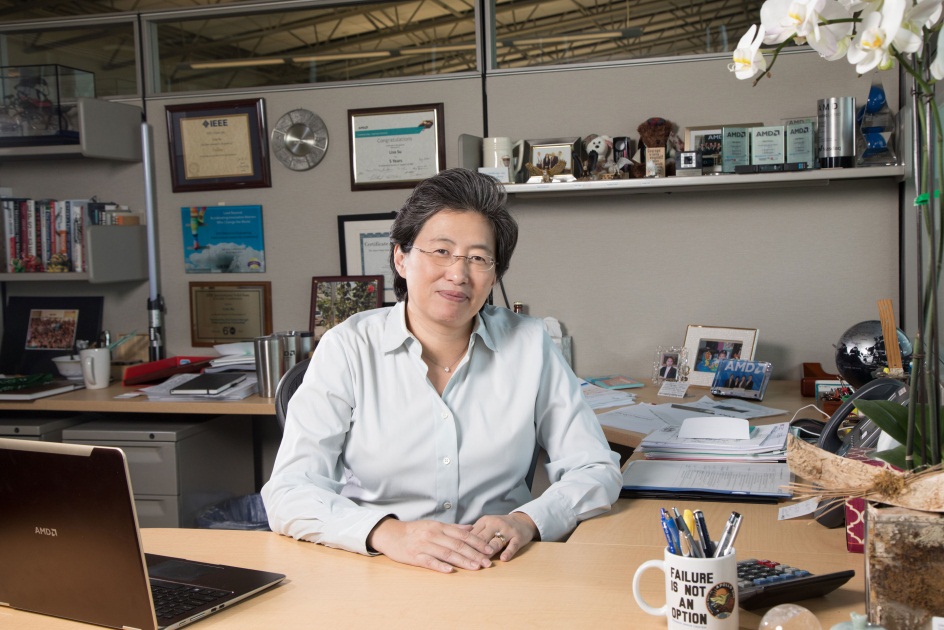
|
測試負(fù)責(zé)人路易斯·卡斯特羅組建的團(tuán)隊(duì)包括80名工程師,他們的任務(wù)是檢測AMD首款采用齊柏林飛艇架構(gòu)的芯片,名為Ryzen。然而,2016年4月進(jìn)行測試的前一天晚上,芯片設(shè)計(jì)團(tuán)隊(duì)主管給卡斯特羅打了電話——設(shè)計(jì)人員進(jìn)行電腦模擬時出現(xiàn)了一個缺陷,AMD的第一顆Ryzen芯片有可能“見光死”,甚至都不能讓計(jì)算機(jī)啟動起來。如果不能迅速解決這個問題,這個芯片項(xiàng)目或許就得延期幾周,甚至幾個月。此時蘇姿豐正在12800公里外的印度出差,跟他們相隔10個時區(qū),這讓情況變得更加復(fù)雜。卡斯特羅回憶說:“在你的職業(yè)生涯里,你從來沒有參與過如此重大的事件。我站起來對自己說,噢,天哪,我該怎么辦?” 負(fù)責(zé)齊柏林飛艇的工程師李·魯斯克給正在為AMD制造芯片的代工廠打了電話,告訴他們立即停止生產(chǎn)。首席技術(shù)官馬克·佩珀馬斯特出面聯(lián)系蘇姿豐,告訴她這個壞消息。通話很緊急,但兩位高管都沒有陷入恐慌。蘇姿豐的第一反應(yīng)很果斷,那就是測試絕不能推遲。 AMD的測試團(tuán)隊(duì)迅速進(jìn)入了蘇姿豐所說的“阿波羅13模式”。四組工程師集思廣益,想找到繞過這顆原型芯片中缺陷的解決方案,以便立即開始測試。一回到奧斯汀,蘇姿豐直奔實(shí)驗(yàn)室給這些人打氣,但她也提醒他們,“絕不能失敗”。 |
Louis Castro, who oversees testing, had assembled a team of 80 engineers to check out the first Zeppelin chip, dubbed the Ryzen. But the night before testing was to begin, in April 2016, the head of the chip design team called Castro. A flaw had slipped through the designers’ computer simulations, and the first chip would be dead on arrival, incapable of even booting up a computer. If the problem couldn’t be quickly fixed, the chip might be delayed for weeks or even months. And to complicate matters, Su was 8,000 miles and 10 time zones away on a business trip in India. “You’ve never been part of something as big as this in your career,” Castro recalls. “I sat and thought to myself, Oh, my gosh, what am I going to do?” Lee Rusk, the engineer in charge of Zeppelin, called the foundry that was making the chip for AMD and told it to stop production immediately. Chief technology officer Mark Papermaster stepped up to call the CEO with the bad news. The conversation was urgent, but neither executive panicked. And Su’s immediate reaction was decisive: Testing couldn’t be delayed. AMD’s team quickly went into what Su calls “Apollo 13 mode.” Four different teams of engineers brainstormed solutions for getting around the flaw in the prototype chip to start testing immediately. As soon as she got back to Austin, Su headed straight for the lab, encouraging the teams while reminding them that “failure was not an option.” |
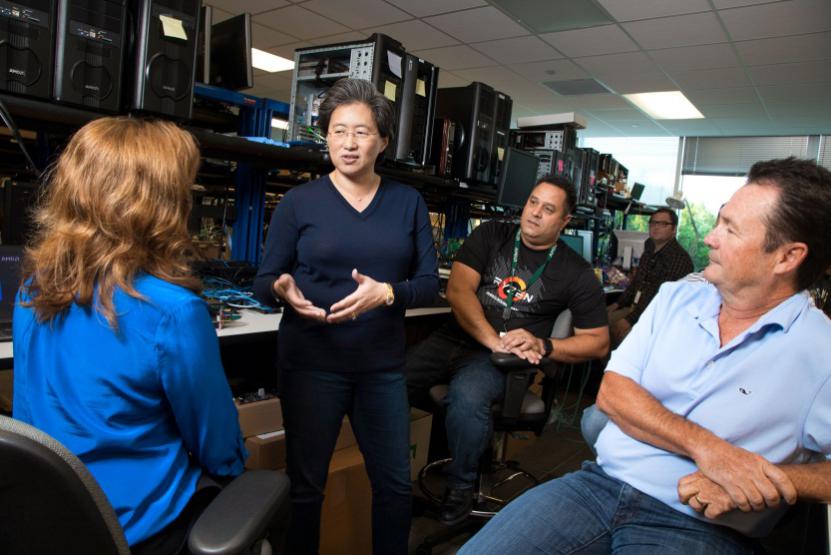
|
今天的電腦和手機(jī)使用的硅芯片無比復(fù)雜。一枚5美分硬幣(直徑約21毫米)大小的Ryzen芯片中集成了500萬個晶體管,分為100層,卡斯特羅的團(tuán)隊(duì)發(fā)現(xiàn)的缺陷影響著不到萬分之一的集成電路。如果它在芯片中的位置更深,在最下面幾層,修復(fù)所需的時間就可能要了他們的命。但AMD抓住了突破點(diǎn)——實(shí)際情況表明,可以花一個月時間在代工廠中糾正這個問題。同時,卡斯特羅的團(tuán)隊(duì)想出了繞過這個缺陷進(jìn)行測試的辦法,連這一個月的時間損失都避免了。 AMD迫切需要一場勝利,而且要快,這一點(diǎn)無需累述。10年來,該公司在大多數(shù)時間里依賴的策略,包括制造基本但不可或缺的芯片,每一、兩年進(jìn)行一次適度升級,以及通過出低價(jià)來贏得競爭,以失敗告終。國際數(shù)據(jù)公司的數(shù)據(jù)顯示,2007-2016年,AMD在PC芯片市場中份額從23%降至10%以下;服務(wù)器芯片方面,AMD的市場份額已經(jīng)不足1%。與此同時,整個PC市場萎縮的速度超過了所有人預(yù)期,而取代PC的移動革命基本上跟AMD擦肩而過。AMD已經(jīng)連續(xù)虧損了5年,2015年收入觸底時堪堪不到40億美元,和2011年的高點(diǎn)相比下跌了39%。 應(yīng)該說,AMD的壞消息是失去了硅谷。在“半導(dǎo)體軍備競賽”中,它和第一名一直相差甚遠(yuǎn)。但AMD一直在用數(shù)不清的方式進(jìn)行創(chuàng)新——作為芯片制造商,它率先突破了1GHz運(yùn)算速度障礙,還是首家在一塊PC芯片中集成兩個處理核心的芯片制造商。在這樣的位置上,AMD一直在為壓低成本做貢獻(xiàn),并讓很多想法暢行無阻,從而惠及無數(shù)依賴運(yùn)算能力的公司。惠普企業(yè)CEO、PC和服務(wù)器行業(yè)老手梅格·惠特曼指出:“在我見過的所有市場中,競爭都是創(chuàng)新的動力。芯片市場有一個廣闊的生態(tài)系統(tǒng),這對整個行業(yè)來說是件好事。” |
The silicon chips at the heart of today’s computers and phones are insanely complex. A single Ryzen chip the size of a nickel has five million transistors, laid out across 100 different layers. The flaw that Castro’s team had found affected fewer than one-hundredth of one percent of the circuits. If it had been located deep in the chip, on one of the lowest layers, repairing it could have been fatally time-consuming. But AMD caught a break: The problem, it turned out, could be corrected at the foundry in a month. And Castro’s team figured out how to get around the flaw for testing, avoiding losing even just that month. It’s hard to overstate how badly AMD needed a win, and a quick one to boot. The strategy it relied on over most of the past decade—building basic but essential chips, rolling out modest upgrades every year or two, and underpricing the competition—has broken down. Between 2007 and 2016, AMD’s market share in PC chips sank from 23% to less than 10%, according to IDC; in server chips, it has dropped below 1%. At the same time the overall PC market has shrunk faster than anyone expected, losing ground to a mobile revolution that largely passed the company by. AMD has lost money for five years in a row, and revenue bottomed out at just under $4 billion in 2015, a 39% decline from its 2011 peak. Bad news for AMD, arguably, is a loss for Silicon Valley. The company has never been anywhere near No. 1 in the semiconductor arms race. But AMD has been an innovator in countless ways—the first chipmaker to break the one-gigahertz speed barrier, the first to put two processing cores in a single chip for PCs. And in that role, it has helped keep costs down and ideas flowing for innumerable businesses that rely on processing power. “Competition drives innovation in every market I’ve ever seen,” says Meg Whitman, CEO of Hewlett Packard Enterprise and now a veteran of the PC and server industries. “A broad ecosystem in the chip market,” she adds, “is a good thing for the industry as a whole.” |

|
如今,AMD看來已經(jīng)不大可能消亡,這在很大程度上要感謝蘇姿豐。她的策略以徹底的重新設(shè)計(jì)為支點(diǎn),而重新設(shè)計(jì)可能有助于AMD在類似于超級計(jì)算機(jī)的處理器市場躍居英特爾和英偉達(dá)之上,此類芯片可以同時進(jìn)行更多的運(yùn)算,并能迅速讀取存儲在用戶計(jì)算機(jī)其他部件上的數(shù)據(jù)。同時,蘇姿豐已經(jīng)開始讓AMD擺脫對PC的依賴,并將注意力集中在向三大游戲主機(jī)廠商,也就是微軟、索尼和任天堂供應(yīng)芯片的業(yè)務(wù)上。她還通過向中國合作伙伴提供服務(wù)器芯片設(shè)計(jì)授權(quán)提高了AMD的利潤。為實(shí)現(xiàn)這一切,蘇姿豐利用了自己的工程師經(jīng)驗(yàn),利用了逾10年來跟IBM建立的關(guān)系,還利用了從蘋果公司這個迷人的獨(dú)立王國中挖來的設(shè)計(jì)人才。 第一批Ryzen芯片今年3月上市,初步反響很強(qiáng)烈。AMD曾承諾,Ryzen的運(yùn)算速度要比上一代芯片高40%,這些芯片則輕松地超額完成了任務(wù)。同時,它們的性能和英特爾的同類芯片相當(dāng),價(jià)格卻不到后者的一半。舉例來說,作為高端臺式機(jī)芯片,Ryzen 7 1800X的售價(jià)為499美元,而英特爾酷睿i7-6900K的價(jià)格為1089美元。投資者也很興奮——AMD的股價(jià)現(xiàn)已升至12美元左右,而2016年初它還在2美元以下苦苦掙扎。 今年夏天將有更多新產(chǎn)品上市——接下來AMD將推出Epyc服務(wù)器芯片,從而對英特爾在這個領(lǐng)域接近壟斷的地位發(fā)起沖擊。隨后亮相的將是圖形處理芯片,也就是GPU Vega。這些芯片對游戲玩家來說意義重大,但不僅如此,它們還是執(zhí)行最先進(jìn)人工智能和機(jī)器學(xué)習(xí)任務(wù)的最佳途徑。這些任務(wù)正是智能助理Siri和Alexa的動力源泉,通用電氣等大型企業(yè)也通過它們來分析大數(shù)據(jù)流。實(shí)際上,對GPU的需求一直在增長,甚至是在PC市場不斷滑坡的情況下。Vega的性能同樣引起了外界關(guān)注——蘋果公司已被說服,將把這款芯片用于即將推出的iMac Pro,也就是今年6月蘋果發(fā)布的純黑色時尚一體機(jī)。 |
Today, AMD’s extinction looks less likely—thanks in large part to Su. Her strategy hinges on radical redesigns that could help AMD leapfrog Intel and Nvidia in the market for supercomputer-like processors, chips that do more calculations simultaneously and speed access to data stored on other parts of a user’s computer. At the same time, Su has begun weaning AMD from its dependence on PCs, focusing on deals to supply chips to the three leading video game console makers: Microsoft, Sony, and Nintendo. She has also boosted the bottom line by licensing server chip designs to a Chinese partner. To accomplish it all, Su is drawing on her experience as an engineer, on relationships she built over more than a decade at IBM—and on design talent poached from the glamorous confines of Apple. The first Ryzen chips hit the market this March, and early reviews are strong. The chips easily exceeded AMD’s promise of 40% faster processing than the previous generation. And they’re matching the performance of comparable Intel chips at less than half the price; a top-end Ryzen 7 1800X chip for desktop computers, for example, sells for $499, while Intel’s Core i7-6900K is $1,089. Investors are excited too: AMD’s stock, which was barely treading water at under $2 a share in early 2016, now trades at about $12. This summer will bring more debuts: Up next is a chip for servers called Epyc—taking on Intel’s near monopoly in that category. Later comes Vega, a graphics chip, or GPU. Such chips have not only become important for gamers but also as the best way to run cutting-edge artificial intelligence and machine learning tasks—the kinds that fuel Siri and Alexa and are used by corporate giants like GE to analyze “big data” streams. Indeed, demand for GPUs is growing even as the PC market remains in a slump. The Vega’s performance has been turning heads too: It convinced Apple to use the chip in its upcoming iMac Pro, the sleek, all-black computer it unveiled in June. ” |
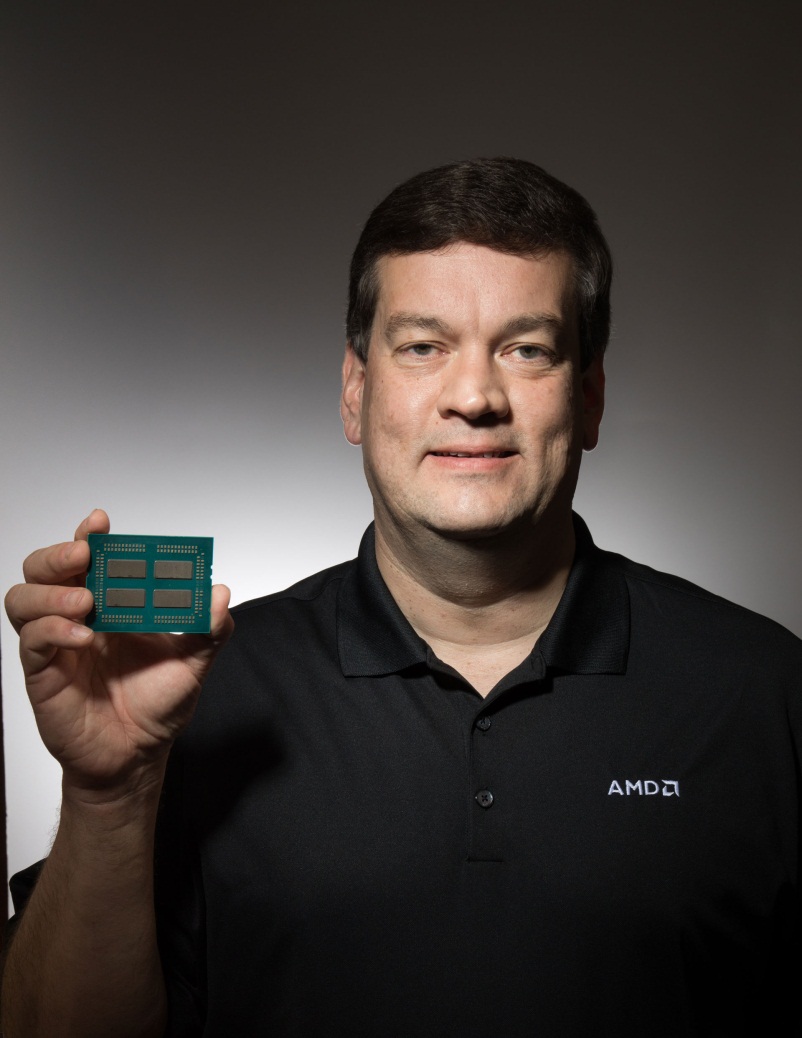
|
不過,上述產(chǎn)品尚未經(jīng)過驗(yàn)證,很難說AMD已經(jīng)擺脫困境。伯恩斯坦研究公司長期跟蹤芯片行業(yè)的分析師斯泰西·拉斯剛認(rèn)為蘇姿豐賭對了方向并且理順了AMD的資產(chǎn)負(fù)債表,但她還沒有證明AMD能夠成功。拉斯剛說:“18個月前AMD的關(guān)注點(diǎn)在于它會不會破產(chǎn),從這個角度來說她干的確實(shí)很好。但對于猜測AMD的執(zhí)行情況,我見過的已經(jīng)太多了。”蘇姿豐的任務(wù)就是掃除這樣的疑問。 拉斯剛所見證的東西和英特爾緊緊糾纏在一起,作為AMD的對手,英特爾的規(guī)模要大得多。兩家公司均由來自半導(dǎo)體先驅(qū)企業(yè)仙童半導(dǎo)體的工程師和高管創(chuàng)立。1968年,羅伯特·諾伊斯、戈登·摩爾和安迪·格魯夫另起爐灶,組建了英特爾。AMD在一年后成立,創(chuàng)始人是銷售員杰里·桑德斯,他自稱為來自芝加哥南部的倔小子。AMD的業(yè)務(wù)在20世紀(jì)80年代實(shí)現(xiàn)騰飛,主要原因是IBM認(rèn)為自己的新PC不應(yīng)完全依賴于英特爾芯片,并將AMD指定為第二家官方供應(yīng)商。在PC芯片領(lǐng)域,AMD一直是兼容英特爾x86架構(gòu)的唯一主要可替代產(chǎn)品制造商。但就算在21世紀(jì)初的巔峰期,盡管AMD的PC芯片市場份額接近四分之一,它依然排在第二位,而且遠(yuǎn)遠(yuǎn)落后于英特爾。 |
With those products still unproven, however, AMD is hardly out of the woods. Stacy Rasgon, the longtime chip industry analyst at Bernstein Research, believes Su has made the right bets and cleaned up the balance sheet but says she has yet to prove AMD can deliver. “In the context of a company where 18 months ago the concern was, are they going bankrupt or not, she’s doing a really good job,” Rasgon says. “But I have too much history with AMD to bet on their execution.” It’s Su’s mission to vanquish such skepticism. That history is tightly intertwined with that of AMD’s far bigger rival, Intel. Both companies were founded by engineers and executives from semiconductor pioneer Fairchild. Robert Noyce, Gordon Moore, and Andy Grove struck out in 1968 to form Intel. The AMD group spun out a year later, under salesman Jerry Sanders, a self-proclaimed tough kid from Chicago’s South Side. AMD’s business took off in the 1980s largely because IBM decided it shouldn’t rely only on Intel for chips for its new personal computer and designated AMD as its official second supplier. AMD remains the only major alternative source for PC chips compatible with Intel’s x86 template—but even at its peak in the 2000s, when it sold nearly one out of every four chips found in PCs, it was always a distant second. |
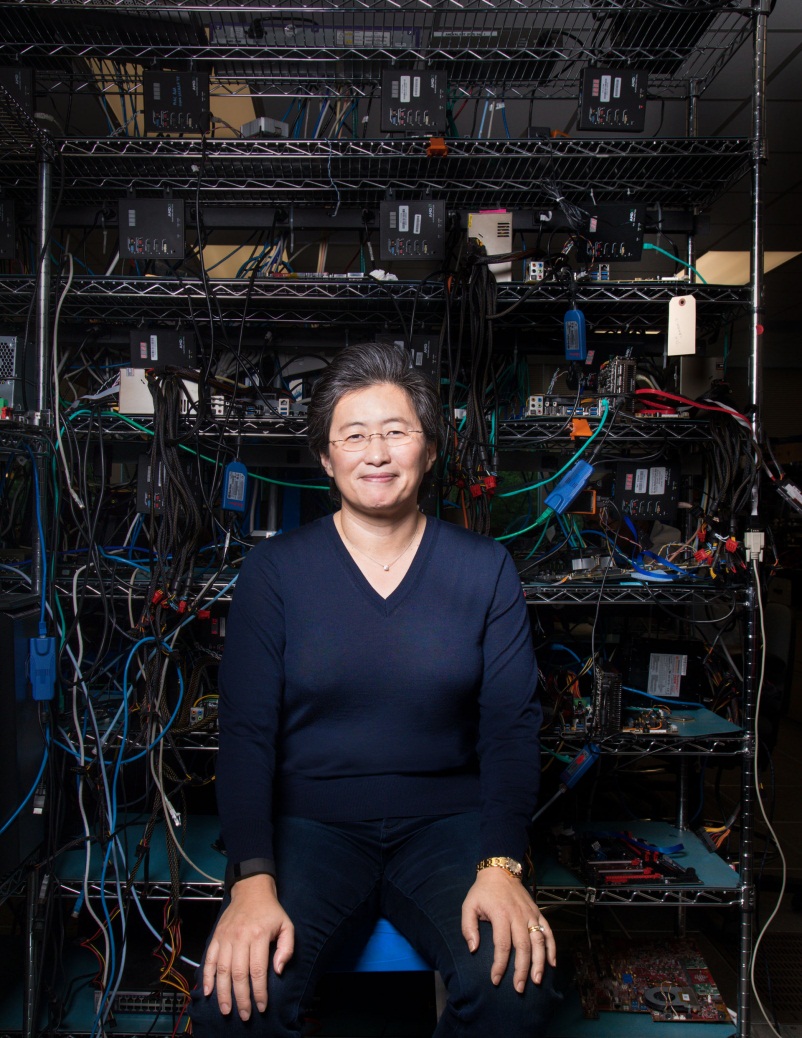
|
在桑德斯及其繼任者赫克特·迪·熱蘇斯·魯伊斯領(lǐng)導(dǎo)下,AMD在20世紀(jì)90年代以及21世紀(jì)初進(jìn)入全盛時期,推出了K6等速度很快的創(chuàng)新型PC芯片,并用這些產(chǎn)品證明AMD不僅僅是英特爾的復(fù)制品。2006年,AMD的股價(jià)達(dá)到逾42美元的高點(diǎn)。但就在這一年,魯伊斯做出了斥資54億美元收購圖形芯片廠商ATI的重大決定。ATI的技術(shù)未能帶來AMD所期待的推動力。此外,本次收購讓AMD在債務(wù)重?fù)?dān)以及合并沖銷的影響下步履維艱,這些年來持續(xù)虧損。2008-2011年,AMD更換了四任CEO。 這就是蘇姿豐接手的爛攤子。她生于臺灣,2歲時隨家人遷往紐約。父母告訴蘇姿豐,她可以成為鋼琴師、醫(yī)生或者工程師。第三種選擇引起了幼年蘇姿豐的共鳴,那時她經(jīng)常把弟弟的電動玩具車拆開,然后試著再裝回去。她上了著名的布朗克斯科技高中,隨后進(jìn)入麻省理工。在這里,蘇姿豐獲得了電機(jī)工程學(xué)士、碩士和博士學(xué)位,對微處理器的興趣也首次在她心里扎了根。 |
AMD reached its prime in the 1990s and 2000s under Sanders and his successor, Hector de Jesus Ruiz, introducing fast and innovative PC chips like the K6 that proved the company was more than an Intel clone. Its stock reached a high of over $42 a share in 2006. But Ruiz made the fateful decision that year to buy graphics-chip maker ATI for $5.4 billion. ATI’s technology never gave AMD the boost it hoped for. What’s more, the deal led to years in the red for the company as it juggled a heavy debt load and merger write-offs. From 2008 to 2011, AMD went through four CEOs. That was the mess inherited by Su. Born in Taiwan, she moved to New York City with her family at age 2. Her parents told Lisa she could be a concert pianist, a doctor, or an engineer. The third choice resonated with a kid who regularly took apart her younger brother’s electric cars and tried to put them back together. She attended the prestigious Bronx High School of Science, then MIT—where her interest in microprocessors first took root—for an undergraduate degree, master’s, and Ph.D. in electrical engineering. |
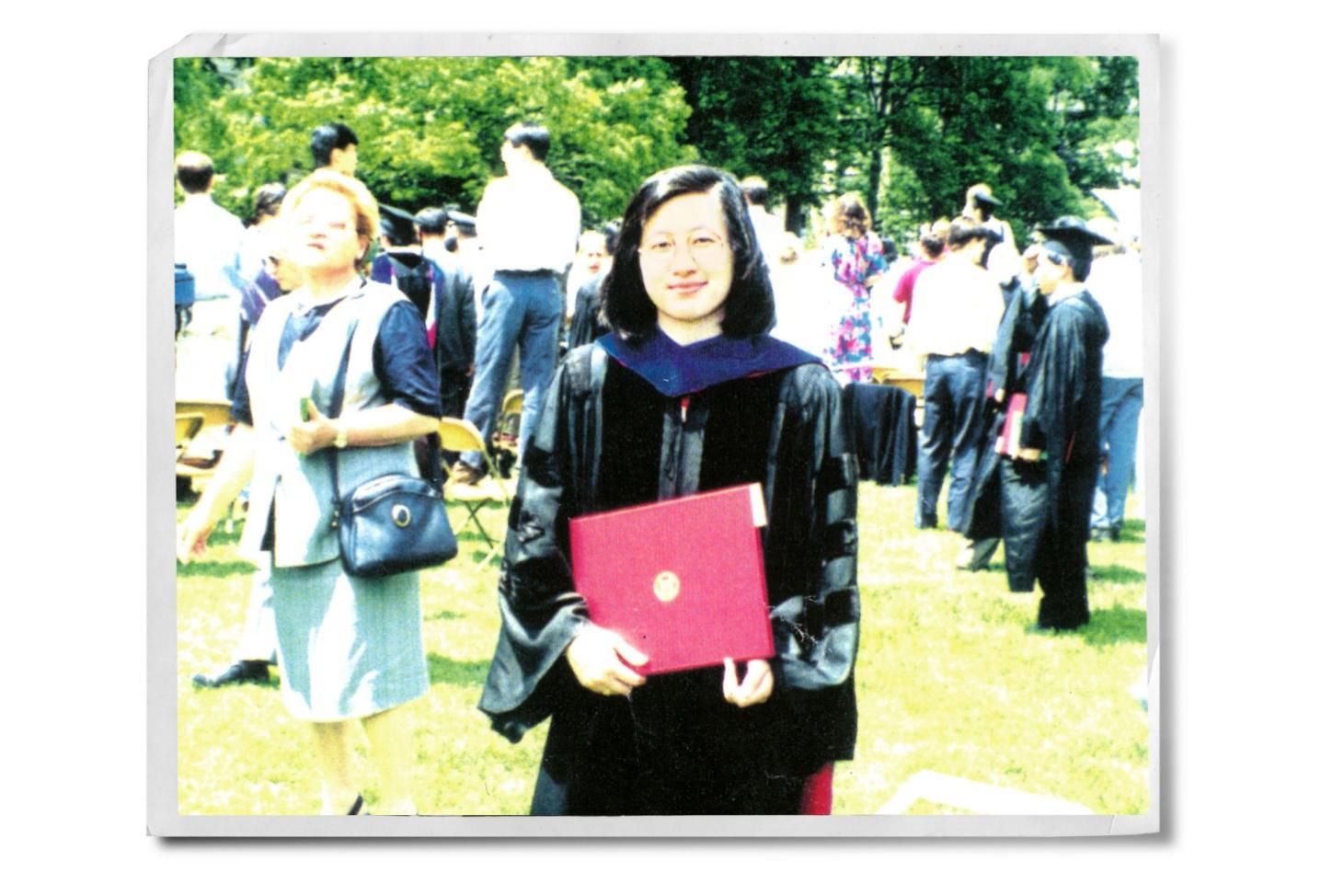
|
在德州儀器工作了很短一段時間后,蘇姿豐進(jìn)入了IBM。在IBM的逾10年光陰里,她一直致力于追求價(jià)格更低、速度更快的芯片,而且遇到了至關(guān)重要的導(dǎo)師尼古拉斯·多諾弗里奧。后者是IBM的傳奇人物。從大型機(jī)到普通PC,多諾弗里奧什么都做過,他安排蘇姿豐擔(dān)任CEO特別技術(shù)助理。當(dāng)時的CEO是來自美國運(yùn)通的郭士納,而蘇姿豐的工作是讓郭士納了解最新的重大技術(shù)進(jìn)展,并且確保技術(shù)培訓(xùn)上的欠缺不會妨礙郭士納進(jìn)行決策。蘇姿豐回憶說:“我的收獲是這份工作讓我看到了大公司CEO如何思考問題。” 郭士納的強(qiáng)項(xiàng)在于簡化可選方案,從而把注意力集中在新技術(shù)究竟怎樣幫助消費(fèi)者的問題上。 蘇姿豐受到了啟發(fā),產(chǎn)生了擔(dān)任管理工作的想法。同時,隨著她不斷取得成功,蘇姿豐感到她在IBM做不到這一點(diǎn)(她強(qiáng)調(diào),女性身份一直都不是障礙。如果說有什么的話,那就是她覺得自己很幸運(yùn),總是能遇到不受性別問題困擾的上司)。2007年,F(xiàn)reescale Semiconductor邀請?zhí)K姿豐擔(dān)任首席技術(shù)官,她也抓住了這個機(jī)會。Freescale Semiconductor是摩托羅拉剝離出的業(yè)務(wù),曾為阿波羅登月項(xiàng)目生產(chǎn)芯片,當(dāng)時需要進(jìn)行全民調(diào)整。蘇姿豐搬到了奧斯汀,最終成為Freescale Semiconductor價(jià)值10億美元的網(wǎng)絡(luò)芯片業(yè)務(wù)負(fù)責(zé)人,并幫助公司在2011年上市。 |
After a brief stint at Texas Instruments, Su went to IBM, where she spent more than a decade focused on the race for cheaper, faster chips. She also met a crucial mentor in Nicholas Donofrio, an IBM legend who had worked on everything from mainframes to the original PC. Donofrio arranged for Su’s appointment as special technical assistant to Lou Gerstner, the then CEO who left American Express to run Big Blue. Su’s job was to keep Gerstner abreast of major technology developments and ensure his lack of technical training didn’t hinder his decision-?making. “What I got as a benefit from it was watching how the CEO of a major corporation thinks,” Su recalls now. ?Gerstner’s strength lay in simplifying the available options, homing in on how new technologies could actually help customers. Su aspired to run a company, and as her star rose she felt she couldn’t do that at IBM. (Being a woman, she stresses, was never an obstacle: If anything, she feels lucky to have always had bosses who were free of gender hang-ups.) In 2007, Freescale Semiconductor, a Motorola spinoff that made chips for the Apollo moon missions and was in need of an overhaul, offered Su the role of chief technology officer, and she seized the opportunity. She relocated to Austin, where she eventually ran Freescale’s $1 billion networking chip division and helped the company go public in 2011. |
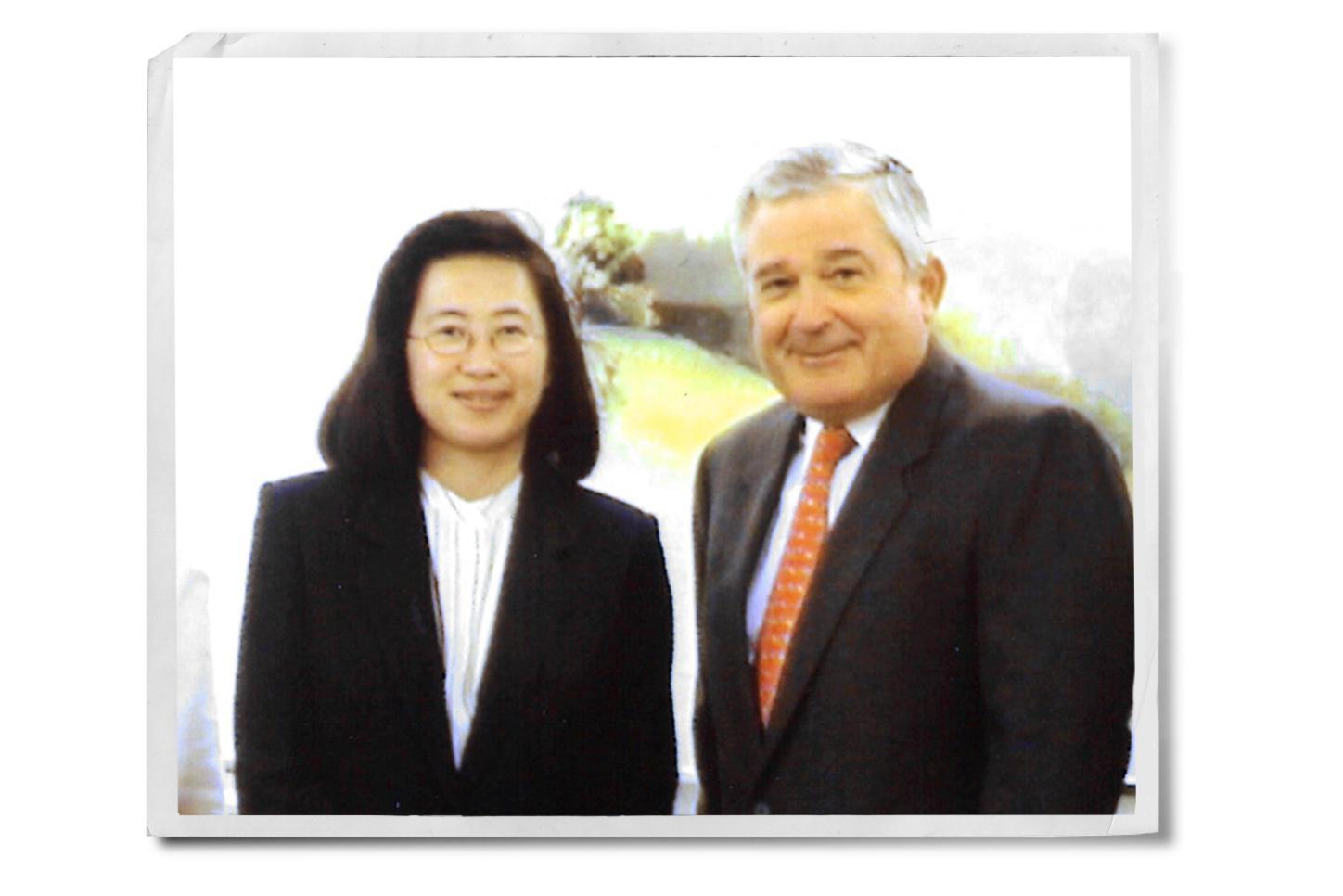
|
當(dāng)時多諾弗里奧已經(jīng)從IBM退休,并且進(jìn)入了AMD董事會,幫助AMD籌劃扭虧戰(zhàn)略。一次,到奧斯汀參加董事會會議的多諾弗里奧請?zhí)K姿豐在豪華的Barton Creek度假村吃晚飯。兩人都擔(dān)心對方因?yàn)樘K姿豐離開IBM而生氣。為緩解緊張氣氛,多諾弗里奧點(diǎn)了一瓶非常貴的思福山坡精選赤霞珠。紅酒入杯時,雙方顯然都不再心懷不滿。多諾弗里奧記得蘇姿豐離開IBM的原因,因而轉(zhuǎn)換了話題。AMD的問題根深蒂固,但也有天才工程師和獨(dú)家知識產(chǎn)權(quán)。多諾弗里奧回憶道,當(dāng)時自己說:“這個時機(jī)太適合你了。”“你說的太對了。”蘇姿豐爽快地答應(yīng)下來,并在2012年進(jìn)入了AMD。2014年,她成了CEO。 那時AMD已經(jīng)組建了設(shè)計(jì)夢之隊(duì),可以重塑它的芯片。多諾弗里奧請來了如今的AMD首席技術(shù)官馬克·佩珀馬斯特,后者是IBM老臣,史蒂夫·喬布斯曾邀請他幫蘋果開發(fā)用于iPhone的系列芯片。反過來,佩珀馬斯特也幫AMD引進(jìn)了其他明星設(shè)計(jì)師,其中最著名的當(dāng)屬2013年加盟的拉加·庫德里。他當(dāng)時在蘋果任職,被外界普遍視為圖形芯片預(yù)言家。庫德里徹底調(diào)整了蘋果的產(chǎn)品線,以便對接高分辨率的Retina顯示屏。 |
By then, Donofrio had retired from IBM and joined AMD’s board to help craft a turnaround strategy. In Austin for a board meeting, Donofrio invited Su to dinner at the tony Barton Creek Resort. Each worried that the other was angry over Su’s departure from IBM. To break the tension, Donofrio ordered a very expensive California cabernet, Shafer Hillside Select, and as the wine flowed it became obvious that neither harbored a grudge. Remembering why Su had left IBM, Donofrio flipped the script. AMD had deeply rooted problems but also had incredible engineering talent and unique intellectual property. “It’s so ripe for you,” Donofrio recalls saying. “It’s so right.” Su jumped at the bait and joined the company in 2012. By 2014, she was CEO. By then AMD had put together a design dream team that could reinvent its chips. Donofrio recruited Mark Papermaster, now the CTO, an IBM veteran whom Steve Jobs had wooed to help Apple develop its own line of chips for the iPhone. Papermaster in turn helped the company bring in other rock-star designers—most notably Raja Koduri in 2013. Widely respected as a graphics-chip visionary, Koduri was at Apple at the time, overhauling its product line to handle high-resolution Retina screens. |

|
在庫德里的家人和朋友看來,從如日中天的蘋果跳到陷入困境的AMD簡直是瘋了。妻子覺得他遭遇了中年危機(jī)。但庫德里漸漸相信,其他平臺或許會取代移動平臺,成為芯片制造創(chuàng)新的核心。連續(xù)幾個小時一直盯著iPhone手機(jī)屏幕后,庫德里突然頓悟。他回憶說:“人們最終會希望把這個東西一直帶在身邊,而不僅僅是放在口袋里。大家會希望隨時接觸到這里的信息。”實(shí)現(xiàn)這一點(diǎn)的也許是虛擬現(xiàn)實(shí),也許是人工智能型數(shù)字助理,亦或是庫德里無法預(yù)見的某種混合體。但它一定需要更多的高性能運(yùn)算,進(jìn)而提升對新型芯片的需求。為重振旗鼓而不顧一切的AMD正好成為他按照清晰方案設(shè)計(jì)此類芯片的場所。庫德里說:“如果在工作時好像自己一無所有一樣,那你就會做出一些相當(dāng)有趣的東西。” 這種“一無所有”的精神正在產(chǎn)生回報(bào)。去年AMD的收入同比上升7%,達(dá)到42億美元。到今年底,圖形芯片業(yè)務(wù)有望發(fā)揮更大作用。2015年,蘇姿豐把AMD的所有圖形芯片業(yè)務(wù)整合成一家名為Radeon Technology的新子公司,并任命庫德里為負(fù)責(zé)人。從那時至今,Radeon Technology的員工人數(shù)增加了60%,成為AMD最大的團(tuán)隊(duì)。蘇姿豐說,AMD的PC芯片“已經(jīng)占據(jù)了主舞臺。現(xiàn)在我們要說,圖形業(yè)務(wù)同樣是一等公民”。 隨著使用新型Vega芯片的產(chǎn)品今夏開售,這項(xiàng)策略很快就會迎來真正的考驗(yàn)。CEO黃仁勛(也是在臺灣出生的美國人,也是電機(jī)工程師)領(lǐng)銜的英偉達(dá)是圖形芯片領(lǐng)域的重量級選手,特別是在軟件方面,該公司特有的CUDA平臺是大數(shù)據(jù)分析的主導(dǎo)性工具。雖然分析師所說的“GPU運(yùn)算”市場很小,但它正在快速成長。伯恩斯坦分析師拉斯剛估算,去年這個市場的銷售額不到5億美元,到2020年將達(dá)到90億美元。AMD正通過打造開源軟件平臺來追趕CUDA。但就連AMD高層都承認(rèn),他們的起步時間已經(jīng)遠(yuǎn)遠(yuǎn)落后。 與此同時,英特爾絕不會退出對PC和服務(wù)器市場的爭奪。COE科再奇把重心放在數(shù)據(jù)中心客戶上。今年5月,英特爾發(fā)布了酷睿i9,也就是性能更強(qiáng)大的臺式機(jī)系列產(chǎn)品。該公司PC芯片業(yè)務(wù)新任負(fù)責(zé)人格雷格·布萊恩特表示:“近一段時間我們在這個領(lǐng)域確實(shí)一直在加速。” 梅格·惠特曼認(rèn)為AMD能和更高級別的選手較量。我們注意到,《財(cái)富》500強(qiáng)(2015年AMD曾因收入未達(dá)標(biāo)而落選)中的女性CEO寥寥無幾,惠特曼和蘇姿豐是其中之二,而且此前蘇姿豐曾請惠特曼傳授擔(dān)任CEO的建議。惠特曼認(rèn)為惠普企業(yè)的服務(wù)器業(yè)務(wù)將成為AMD Epyc芯片的主要受益者(和買家)。她指出:“為什么蘇姿豐能在別人失敗的地方取得成功?她讓公司把注意力集中在打造出色的產(chǎn)品上。從頭至尾,就是這樣。” 蘇姿豐定期到世界各地出差時都會講這個故事。今年6月一個陽光明媚的日子,她再次來到波士頓地區(qū),和一些潛在客戶會面。在她獲得博士學(xué)位差不多25年后,蘇姿豐的母校麻省理工邀請她給大約500名博士畢業(yè)生講話。蘋果CEO蒂姆·庫克(畢業(yè)于奧本大學(xué)和杜克大學(xué)商學(xué)院)會在第二天的全校畢業(yè)典禮上發(fā)言,蘇姿豐則是博士生畢業(yè)典禮上的演講嘉賓。 |
Jumping from Apple, at the height of its dominance, to struggling AMD seemed crazy to Koduri’s friends and family. His wife thought he was having a midlife crisis. But Koduri had come to believe that other platforms might displace mobile as the locus for innovation in chipmaking. Staring at the display of an iPhone for hours on end, he had an epiphany. “Man eventually wants to carry this thing around with him all the time, not just in his pocket,” Koduri recalls. “You want access to this information all the time.” That might be attained through virtual reality or digital assistants fueled by artificial intelligence, or some mix Koduri couldn’t foresee. But it was bound to boost demand for high-performance computing—and new kinds of chips. And AMD’s desperation for renewal made it the place where he could design such chips with a clean slate. “If you work like you have nothing to lose, you can do some pretty interesting things,” he says. The “nothing to lose” ethos is beginning to pay dividends. Last year AMD’s revenue rose 7% over the previous year, to $4.2 billion. By the end of this year, the graphics business could be pulling more weight. In 2015, Su put all AMD’s graphics-chip work under Koduri in a new unit called the Radeon Technology Group. Radeon’s headcount has risen 60% since then, to 3,200, making it the largest team in the company. AMD’s PC chips “had taken the limelight,” Su says. “Now we’re saying that graphics is also a first-class citizen.” Soon will come the real test of the strategy, as products with the new Vega chips go on sale this summer. Nvidia, under CEO Jensen Huang (another ?Taiwanese-born American trained as an electrical engineer), is a powerful player in graphics, particularly on the software side, where its proprietary CUDA platform dominates as a tool for big-data analysis. Although the market for what analysts call “GPU compute” is small, it’s growing fast. From under $500 million in sales last year, it will hit close to $9 billion by 2020, Bernstein’s Rasgon estimates. AMD is building an open-source software platform to catch up to CUDA. But by its executives’ own admission, it’s starting far behind. Intel, meanwhile, is far from folding its tent in the competition for PCs and servers. CEO Brian Krzanich is focusing attention on data center customers, and in May Intel unveiled a higher-performance desktop line dubbed the Core i9. “We really stepped on the accelerator in this space a while back,” says Greg Bryant, the new head of Intel’s PC chip unit. Meg Whitman, for one, thinks AMD will punch above its weight. Notably, Whitman and Su are among the few women who have reached the ranks of CEO at a Fortune 500 company (though AMD’s recent revenue woes bumped it off that list in 2015), and Su consulted Whitman early on for advice about being a CEO. Whitman thinks Hewlett Packard Enterprise’s core server business will be a big beneficiary (and buyer) of AMD’s Epyc chip. “Why did Lisa succeed where others failed?” she asks. “She has focused that company on building great product. Beginning, middle, end of story.” Su regularly travels the world to pitch that story. And on a sunny day this June she was back in the Boston area, mingling with some likely future customers. Almost 25 years after she earned her own doctorate, Su’s alma mater, MIT, invited her to speak to the 500 or so graduates receiving a Ph.D. Apple CEO Tim Cook (an Auburn University and Duke business school grad) would address the school’s full graduation the next day, but it was Su who spoke at the event where the doctoral recipients got their ceremonial hoods. |
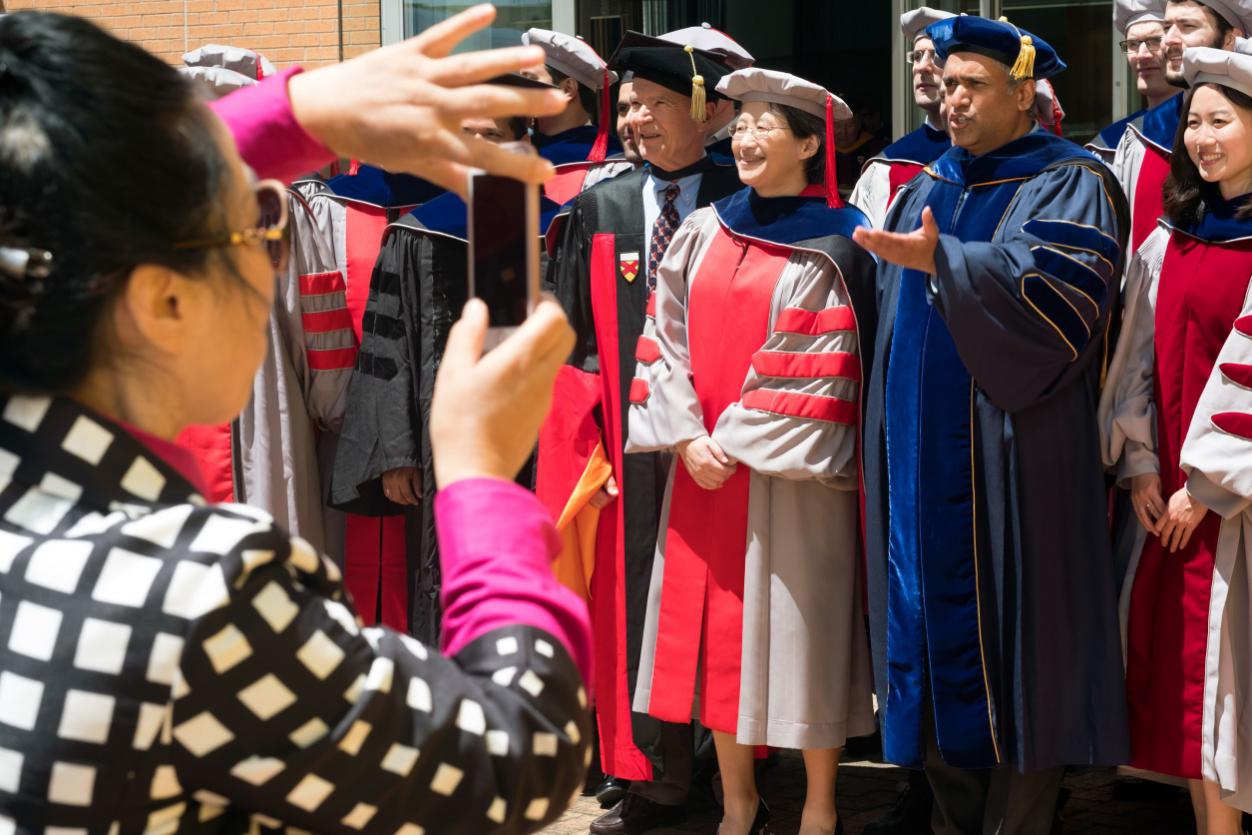
|
蘇姿豐在自己寫的發(fā)言稿(很多公司高管都會找人代勞)中向畢業(yè)生們提出了挑戰(zhàn),要求他們有遠(yuǎn)大夢想,把握自己的命運(yùn),并且改變這個世界。她還顯露出了自己富有競爭性的一面。她在最后說:“你們要向我保證,你們會努力工作,從而確保今后會有許多哈佛MBA給麻省理工的博士生打工。”這句話贏得了聽眾由衷的喝彩。隨后,她的名氣得到了印證——畢業(yè)生們請她合影,教授們則上前和她討論芯片設(shè)計(jì)以及摩爾定律。 智能手機(jī)前,蘇姿豐認(rèn)真地?cái)[著姿勢,并和大家親切交談,隨后躲進(jìn)了附近一家狹小的中餐館,這是她學(xué)生時代最喜歡的就餐場所之一。她坐在丈夫身邊,點(diǎn)了塑料菜單上幾樣最辣的菜。放松下來后,蘇姿豐總結(jié)了她的發(fā)言主旨:“我正在進(jìn)行自己的一系列戰(zhàn)斗,而且我覺得很過癮。你們每個人都可以選擇自己想要的戰(zhàn)斗,而且都可以獲勝。”(財(cái)富中文網(wǎng)) 本文將刊登在2017年7月1日出版的《財(cái)富》上,題為《拿出嶄新芯片,賭上一切》(Betting It All, With Brand-New Chips)。 譯者:Charlie 審稿:夏林 |
In a speech she wrote herself (a task many execs delegate), Su challenged the graduates to dream big, make their own luck, and change the world. Her competitive streak also came out. “Promise me that you will work hard at ensuring that there are lots of Harvard MBAs working for MIT Ph.D.s in the future,” she concluded to hearty applause. Afterward her celebrity status was confirmed as graduates asked her to pose for selfies and professors approached to discuss chip design and Moore’s law. Su dutifully posed for the smartphones and chatted amiably before retreating to a nearby hole-in-the-wall Chinese restaurant, a favorite from her student days. Sitting next to her husband and ordering some of the spiciest dishes from the plastic menus, a relaxed Su summed up what she was trying to get across in her speech. “I’m fighting my set of wars, and I’m having a great time,” Su said. “Each of you can pick a war that you want to fight, and you can win it.” A version of this article appears in the July 1, 2017 issue of Fortune with the headline "Betting It All, With Brand-New Chips." |













